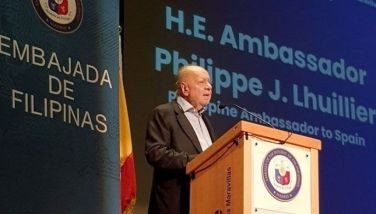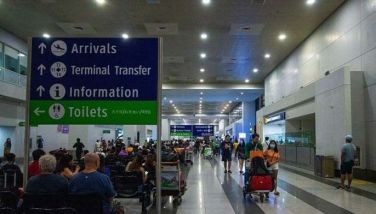Intel sets add’l investment of $100M in RP
March 14, 2002 | 12:00am
Despite the still sluggish market for personal computers, computer chip giant Intel Corp. says it will continue investing in its Philippine operations, starting with $100 million to expand its factory here this year.
New Intel president and chief operating officer Paul S. Otellini, who visited the Philippines for a four-nation Asian tour, said they are consolidating their operations here by the third quarter of this year, a move that could lead to the closure of its manufacturing facility in Makati City.
"The plan is to consolidate our activities in Cavite where we have newer technology. We’ll see as we move. We expect to complete that by July or August this year," Otellini said. The company plans to increase the capacity of the Cavite facility instead.
He stressed: "The Intel strategy year in and out is to invest. We consider long term growth prospects. Most of our competitors are reducing their investments but we increase our investments during a downturn. (This way), we can exit transitions stronger when we entered."
Otellini said that this year, Intel will invest a total of $100 million for capacity expansion and technology. From producing legacy products, Intel will upgrade manufacturing to higher value chipsets and microprocessors. The company is undertaking similar activities in Malaysia and Shanghai in China. Intel will expand capacity and introduce 300-mm technologies for its microprocessors.
Intel Philippines has been operating for 27 years, having invested a total of $1.3 billion (P68 billion) in the country.
"We are increasing our investments here, putting in $100 million this 2002 to expand the size of our factory," according to Otellini.
Globally, Intel invested $7.5 billion last year to increase the capacity of its semiconductor manufacturing plants. This year, it is investing over $5 billion. Overall, it has allocated $13 billion for the capacity build-up of its factories between 2003 and 2005.
Aside from aggressive investing, Intel’s strategy is hinged on building great products and leading the technology growth in emerging markets. "Our ultimate goal is to merge computing and communications, to make any device interact seamlessly with any other device, anytime, anywhere in the world," Otellini said.
The Intel top executive however expressed concern over the state of the country’s infrastructure, the high cost of power and its ability to create a (good) environment for information technology.
Nevertheless, Otellino underscored, "I’m optimistic for the year-on-year growth for us and for the industry for 2002."
In an interview, he said that during the fourth quarter of last year, the company’s revenues from the Asia Pacific region surpassed the Americas for the first time.
"More business and individual consumers are buying personal computers in Asia Pacific. I don’t see that trend abating over time. And there are a lot more people here than in the North and South America’s," he said.
In the past seven or eight years, Intel had been investing in the emerging markets. And the strategy is paying off. By 2002, 70 percent of the company’s revenues are coming from this region.
"In the toughest year of the industry, the emerging market grew tremendously. And this market represents a very significant part of PC sales in the next four to five years," says Otellini.
Worldwide, Intel estimates that some 450 million PCs are already, obsolete. These are in the 700 megahertz range which cannot run new applications.
New Intel president and chief operating officer Paul S. Otellini, who visited the Philippines for a four-nation Asian tour, said they are consolidating their operations here by the third quarter of this year, a move that could lead to the closure of its manufacturing facility in Makati City.
"The plan is to consolidate our activities in Cavite where we have newer technology. We’ll see as we move. We expect to complete that by July or August this year," Otellini said. The company plans to increase the capacity of the Cavite facility instead.
He stressed: "The Intel strategy year in and out is to invest. We consider long term growth prospects. Most of our competitors are reducing their investments but we increase our investments during a downturn. (This way), we can exit transitions stronger when we entered."
Otellini said that this year, Intel will invest a total of $100 million for capacity expansion and technology. From producing legacy products, Intel will upgrade manufacturing to higher value chipsets and microprocessors. The company is undertaking similar activities in Malaysia and Shanghai in China. Intel will expand capacity and introduce 300-mm technologies for its microprocessors.
Intel Philippines has been operating for 27 years, having invested a total of $1.3 billion (P68 billion) in the country.
"We are increasing our investments here, putting in $100 million this 2002 to expand the size of our factory," according to Otellini.
Globally, Intel invested $7.5 billion last year to increase the capacity of its semiconductor manufacturing plants. This year, it is investing over $5 billion. Overall, it has allocated $13 billion for the capacity build-up of its factories between 2003 and 2005.
Aside from aggressive investing, Intel’s strategy is hinged on building great products and leading the technology growth in emerging markets. "Our ultimate goal is to merge computing and communications, to make any device interact seamlessly with any other device, anytime, anywhere in the world," Otellini said.
The Intel top executive however expressed concern over the state of the country’s infrastructure, the high cost of power and its ability to create a (good) environment for information technology.
Nevertheless, Otellino underscored, "I’m optimistic for the year-on-year growth for us and for the industry for 2002."
In an interview, he said that during the fourth quarter of last year, the company’s revenues from the Asia Pacific region surpassed the Americas for the first time.
"More business and individual consumers are buying personal computers in Asia Pacific. I don’t see that trend abating over time. And there are a lot more people here than in the North and South America’s," he said.
In the past seven or eight years, Intel had been investing in the emerging markets. And the strategy is paying off. By 2002, 70 percent of the company’s revenues are coming from this region.
"In the toughest year of the industry, the emerging market grew tremendously. And this market represents a very significant part of PC sales in the next four to five years," says Otellini.
Worldwide, Intel estimates that some 450 million PCs are already, obsolete. These are in the 700 megahertz range which cannot run new applications.
BrandSpace Articles
<
>
- Latest
- Trending
Trending
Latest
Trending
Latest
Recommended
November 18, 2024 - 12:00am


























